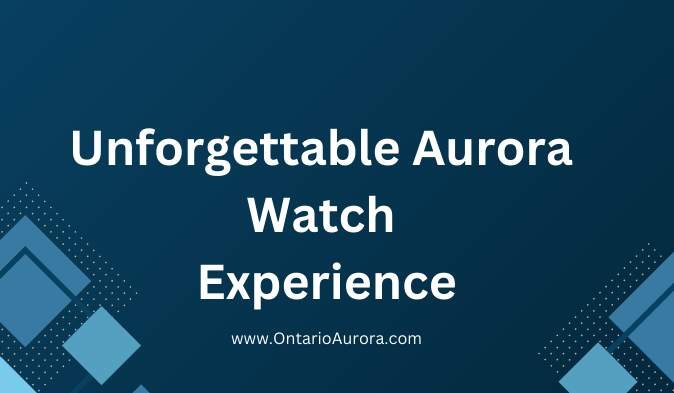
Not only is Aurora renowned for its people’s achievement and education, you will too enjoy Aurora Watch Experience but it is also renowned for its richness and abundance of natural heritage, making it one of Canada’s wealthiest communities.
Nature creates the breathtaking auroras, a light display that has captured people’s attention for ages throughout the enormous span of the northern and southern polar regions.
When charged solar particles collide with Earth’s magnetic field, they produce the Northern Lights (Aurora Borealis) and Southern Lights (Aurora Australis).
An “Aurora Watch” has evolved into a vital tool for both ardent aurora aficionados and inquisitive stargazers to anticipate and observe these ethereal phenomena.
Understanding Aurora Watch:
The phrase “Aurora Watch” describes the observation and forecasting tools intended to notify observers when there is a significant chance that they will see auroras.
To produce precise forecasts, these systems integrate real-time data from multiple sources, including satellite imaging, geomagnetic activity, and solar wind measurements.
Aurora Watch services are provided by a number of organizations and websites, enabling aficionados to meticulously organize their trips in search of auroras.
Solar Activity and its Impact:
The tracking of solar activity is the main component of Aurora Watch. The sun is a dynamic celestial body with its own cycles of activity, not just a stationary ball of fire.
The solar wind is produced when charged particles are sent into space by solar flares and coronal mass ejections.
The magnificent auroras are created when these particles interact with the Earth’s magnetosphere, especially when solar activity is strong.
NASA’s Role in Aurora Monitoring:
NASA and other space agencies are essential sources of data for Aurora Watch. Solar wind speed, density, and magnetic field intensity are continuously measured by satellites such as the Advanced Composition Explorer (ACE) and the Solar Dynamics Observatory (SDO), which track the sun.
The ability to forecast geomagnetic storms, which are the source of powerful auroras, is greatly enhanced by this data.
Aurora Watch Websites and Apps:
Numerous websites and applications provide real-time Aurora Watch information for travelers and amateur astronomers interested in seeing the auroral show.
Sites such as the Space Weather Prediction Center (SWPC), Aurora Watch UK, and the Aurora Service offer forecasts, live updates, and even alerts when aurora visibility is expected in a given area.
Planning Your Aurora Adventure:
With the use of Aurora Watch data, enthusiasts can more precisely plan their trips to see the aurora. Selecting areas with low light pollution and ideal viewing circumstances improves the experience.
The far-flung regions of Iceland, Tromsø in Norway, and Fairbanks, Alaska, are popular spots to see auroras.
Photographing the Auroras:
Auroras are a photographer’s fantasy as well as a visual treat. It takes some expertise and the appropriate tools to capture the dancing lights against a pitch-black, starry sky.
In order to capture the beauty of the night sky, photographers frequently go out into the field at night with DSLR cameras, strong tripods, and wide-angle lenses.
The Cultural Significance of Auroras:
Beyond their scientific appeal, many indigenous tribes in arctic locations attach great cultural value to auroras.
These cultures have been woven with tales of spirits, gods, and celestial wars over the millennia, all related to the Northern Lights.
In this sense, Aurora Watch acts as a link between traditional wisdom and contemporary research.
The Future of Aurora Watch Technology:
It is anticipated that as technology develops, Aurora Watch predictions will become more accurate.
An enhanced comprehension of the intricate relationships between the sun and Earth will be possible through the use of more advanced satellites and ground-based devices.
Aurora forecasts may also be improved and made even more accurate by artificial intelligence and machine learning techniques.
Conclusion:
With the help of Aurora Watch, aficionados can enter the enchanted realm of auroras and observe one of nature’s most magnificent occurrences.
Around the world, people are still enthralled with the Northern and Southern Lights, for reasons ranging from the scientific marvel of solar activity to the cultural richness of indigenous stories.
Aurora Watch makes sure that we can anticipate and be in wonder of the symphony of lights in the night sky as long as technology keeps progressing.
Aurora Watch thus extends an invitation to partake in the celestial display and witness the magic of the auroras firsthand, regardless of your level of experience with travel or astronomy.
For more information, click here:- https://www.swpc.noaa.gov/products/aurora-30-minute-forecast
FAQs on Aurora Watch:
Q1. What causes the Northern and Southern Lights specifically?
When charged solar particles collide with gasses in Earth’s atmosphere, the result is the aurora. The particular hues vary according to the kind of gas and its height.
Q2. Is there a particular season that is best for seeing auroras? How frequently do they occur?
Auroras are typically seen at times of high solar activity and are more frequent in the vicinity of the polar regions. Though their frequency fluctuates, they are frequently seen in the summer and winter.
Q3. How does the solar wind factor into the predictions of Aurora Watch?
An essential function is played by the solar wind, a stream of charged particles expelled from the sun. Auroras are more likely to occur when solar wind interacts with Earth’s magnetic field, causing geomagnetic storms.
Q4. Is it possible to see auroras from anywhere on Earth?
Strong geomagnetic storms have the ability to extend the auroras to lower latitudes, even though the polar areas provide the finest views. But they are seldom seen close to the equator.
Q5. What influences the dependability of Aurora Watch predictions, and how accurate are they?
Although light pollution and local weather conditions might affect visibility, predictions are generally accurate. The strength of the auroras is also influenced by geomagnetic storms.
Q6. Is witnessing auroras related to any health risks?
There is no harm to one’s health when seeing auroras. However, suitable attire may be necessary because of the frigid temperatures in polar locations where they are frequently visible.
Q7. Do auroras emit noises?
The phenomenon is usually silent, though there have been anecdotal reports of mild hissing or crackling sounds during powerful auroras. Electromagnetic activity interacting with the Earth’s atmosphere could be the source of the sounds.
Q8. Is it possible to forecast when exactly an aurora would show up during an Aurora Watch alert?
Accurately predicting the exact moment is difficult. Alerts for aurora watches offer a window of opportunity when auroras are most likely to be seen, while the precise timing can change.
Q9. Why do auroras have varying colors when they appear?
The kind of gas particles in the Earth’s atmosphere and their height determine the hues of the auroras. At higher elevations, oxygen can produce red and green colors, whereas nitrogen can provide pink and purple hues.
Q10: Can one observe the auroras from space?
Indeed, auroras have been seen from space by astronauts on board the International Space Station. Seeing the lights dance around the earth is an amazing experience, according to them.
Q11. What is the best way to take pictures of auroras?
A strong tripod, a wide-angle lens, and a DSLR camera with manual settings are needed to take beautiful aurora pictures. To capture the vibrant colors, long exposure photos in low light are frequently utilized.
Q12. Are there any recommended procedures for organizing a vacation to see aurora borealis?
It’s crucial to pick a spot with less light pollution, keep an eye out for Aurora Watch alerts, and be ready for frigid temperatures. Also, since auroras might not appear right away, patience is essential.
Q13: Is it possible to observe auroras during the day?
Because of how brilliant the sun is during the day, auroras are typically not seen. The ideal time to watch them is at night, during the gloomy hours.
Q14: What meanings do native civilizations attach to the auroras?
The auroras are the subject of rich legend in many indigenous societies, who attribute the lights to spirits, ancestors, or celestial creatures. These communities find spiritual and cultural meaning in the lights.
Q15: How does artificial intelligence contribute to more accurate Aurora Watch forecasts?
In an effort to evaluate large volumes of data faster and more accurately, several forecasting algorithms are experimenting with artificial intelligence and machine learning. This could result in forecasts of the Aurora Watch that are more precise and timely.
RELATED POSTS
View all



